Servo Magazine ( )
New Products (01.2019)
DYNAMIXEL Pro Plus H Series
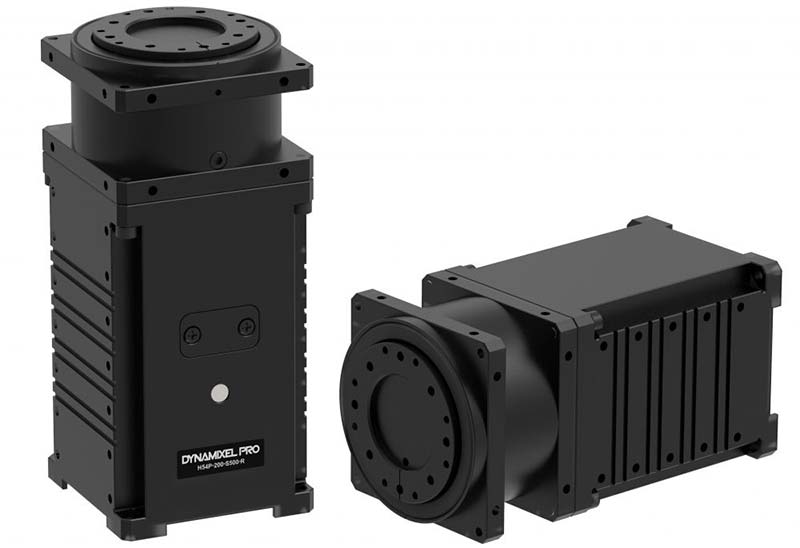
Following the discontinuation of ROBOTIS’ DYNAMIXEL Pro H Series and M Series actuators, the new DYNAMIXEL Pro Plus H Series has now been released.
Some of the improved features of the new DYNAMIXEL Pro Plus include:
- External Design (Housing, JST Connector)
- Improved Dust Resistance/Lubricant Seal (54 Series)
- Improved Control Table (Inherits X Series Features)
- Improved Servo Control Performance (Response, Resolution)
- Improved Communication Performance (Communication Response, Modbus supported)
- Improved H/W Reliability (Heat, Noise, Durability)
Pricing starts at $1,390. Dynamixel Pro+ series is a self-developed high performance all-in-one actuator equipped with a cycloid reducer. Additional features include:
- Torque control based on current sensing.
- Increased reliability and accuracy for position and speed control through PID control.
- High resolution with combination of incremental encoder and contactless absolute encoder.
- Full metal housing for high durability.
- Can be used to make a full-size manipulator, pan tilt, humanoid, etc.
PRO+ upgrade details include:
- Improved design and JST connectors applied.
- Improved dirt inflow and leakage (54 Series).
- Improved control table (supports X-series functions).
- Enhanced control performance such as responsiveness and resolution.
- Enhanced communication responsiveness.
- Improved heat, noise, and durability.
DYNAMIXEL X-Series Actuator Modules
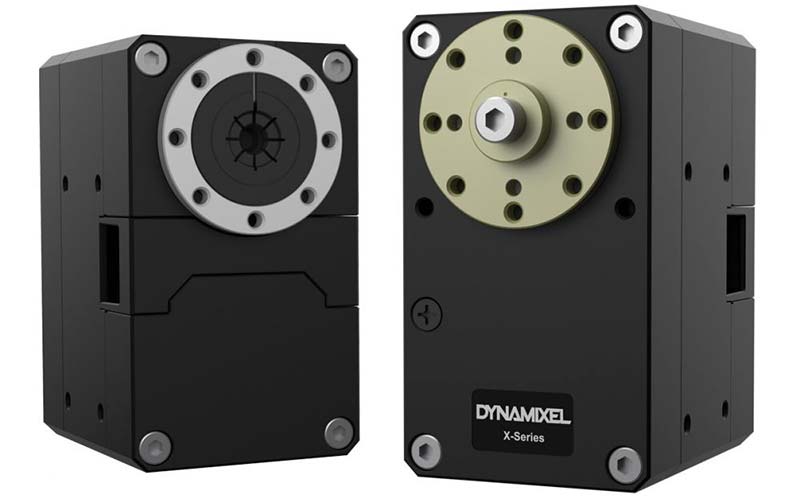
The DYNAMIXEL X-Series is a new line-up of high-performance networked actuator modules, which have been widely used for building multi-joint robots with reliability and expandability. The DYNAMIXEL XM540-W270-T is priced at $349.90
DYNAMIXEL is a robot exclusive smart actuator with fully integrated DC motor, reduction gearhead, controller, driver, and network in one DC servo module.
The DYNAMIXEL XH/XM series offers a variety of control techniques based on high-performance current sensing algorithms. It adopts the aluminum case and adopts the new technology such as the hollow cable fastening structure for user’s convenience.
Additional features include:
- Six operating modes.
- Torque, velocity, position, extended position, current based position, and PWM control.
- Profile control for smooth motion planning.
- Improved heatsink featuring an aluminum case.
- Hollow back case minimizes cable stress (three-way routing).
- Direct screw assembly to the case (without nut insert).
- Energy savings (reduced current from 100 mA to 40 mA).
- A 28.4% reduced volume compared to the MX-106.
- Support synchronous control mode.
- External I/O port support.
For further information, contact:
ROBOTIS
www.robotis.us
Second Generation Motor Controllers with Feedback
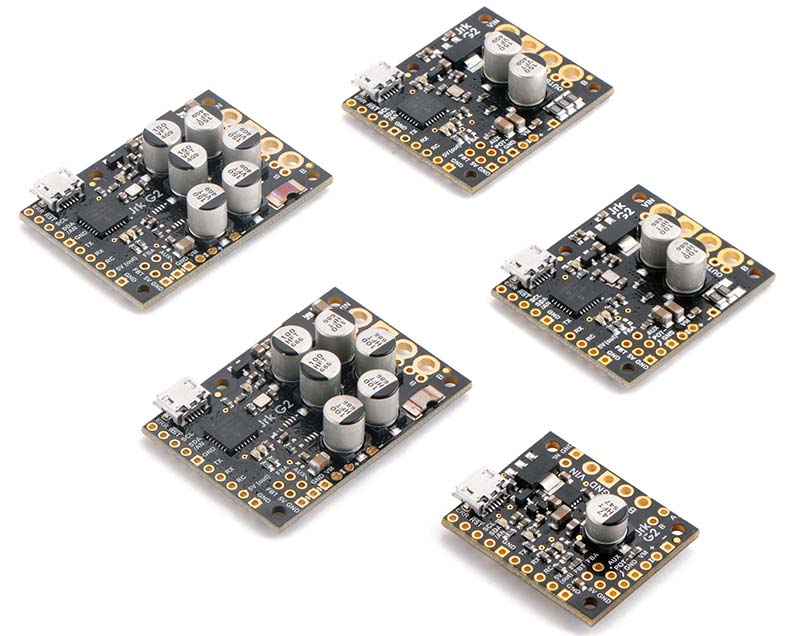
Pololu’s second generation of Jrk motor controllers with feedback is now available. With integrated support for analog voltage or tachometer (frequency) feedback, the Jrk family of motor controllers makes it easy to add closed-loop control of speed or position (but not both) of a single brushed DC motor to a wide range of applications.
These versatile general-purpose modules support a variety of high-level control interfaces: USB for direct connection to a computer; TTL serial and I²C for use with a microcontroller; RC hobby servo pulses for use in an RC system; and analog voltages for use with a potentiometer or analog joystick.
The Jrk G2 motor controllers also offer many settings that can be configured using Pololu’s free configuration software utility for Windows, Linux, and macOS. This software simplifies initial setup of the device and allows for in-system testing and monitoring of the controller via USB.
Configurable parameters include PID period and PID coefficients (feedback tuning parameters), maximum current, maximum duty cycle, maximum acceleration and deceleration, error response, input calibration (learning) for analog and RC control, and more. The software can also plot nearly a dozen system parameters in real time including feedback, error, duty cycle, and current, easing the process of configuring your system for optimal performance.
Some additional features of the Jrk G2 controllers include reverse-power protection, field-upgradeable firmware, optional feedback potentiometer disconnect detection, more accurate speed control at low tachometer frequencies than their predecessors, and VIN measurement capability which allows monitoring of the battery or power supply. Five versions are available, with prices ranging from $49.95 for the tiny Jrk G2 21v3 (4.5V to 28V, 2.6A continuous) to $149.95 each for the high-power Jrk G2 18v27 (6.5V to 30V, 27A continuous) and Jrk G2 24v21 (6.5V to 40V, 21A continuous).
Carrier Boards for Bipolar Stepper Motor Drivers
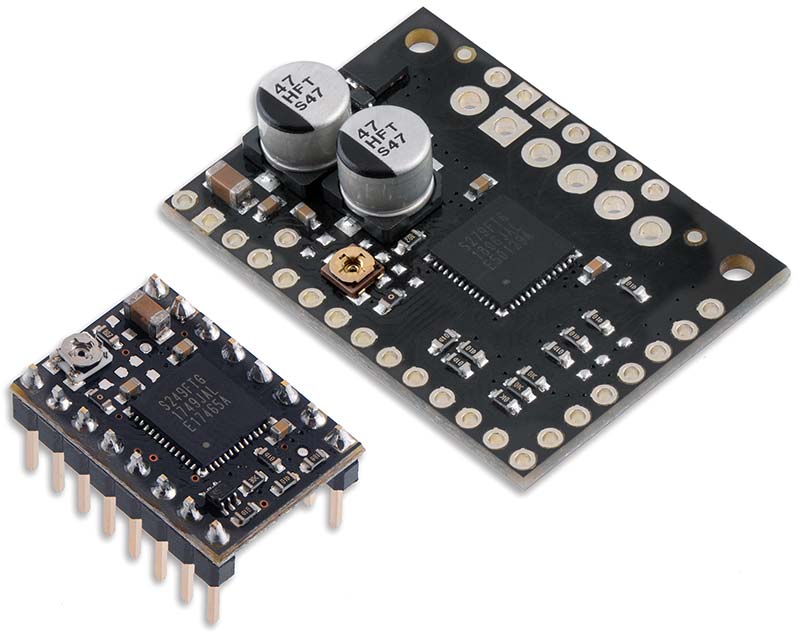
Pololu also announces the release of carrier boards for Toshiba’s new TB67S249FTG and TB67S279FTG bipolar stepper motor drivers (the only difference between the two is the maximum current supported). In addition to typical features such as configurable current limiting and microstepping down to 1/32-steps, these new products offer several innovative features that set these drivers apart from the multitude of integrated stepper drivers currently on the market.
One particular new feature is Toshiba’s Active Gain Control (AGC) which automatically reduces the stepper motor current below the set limit based on the actual load on the motor, allowing for reduced unnecessary heat generation and higher peak power when the motor actually needs it. The drivers also incorporate Toshiba’s Advanced Dynamic Mixed Decay (ADMD) technology which dynamically switches between slow and fast decay modes based on the actual motor current, providing higher efficiency and smoother steps at high speed than you get with traditional timing-based mixed decay.
Two carrier boards are available for each driver chip: a larger module that provides access to all of the integrated circuit’s pins so you can test all the features it offers; and a compact carrier in the popular 16-pin 0.6” x 0.8” Pololu form factor, which makes it easy to use the new drivers on RAMPS-type 3D printer controllers that have the compatible sockets.
Both the TB67S249FTG and TB67S279FTG have the same wide operating voltage range of 10V to 47V, and on the compact carrier boards, they can respectively deliver continuous currents up to 1.7A and 1.2A per phase (4.5A and 2A peak) without additional cooling.
The maximum current is slightly higher on the larger carriers because of the better heat dissipation due to the increased board size. The drivers feature a built-in regulator so no external logic voltage supply is needed, and they can interface directly with 3.3V and 5V systems.
The compact carriers have single-piece pricing starting at $9.95 for the TB67S249FTG and $7.75 for the TB67S279FTG, and they are available with or without header pins soldered. The larger full breakout versions are $11.95 and $9.75 each in single-unit quantities.
For further information, contact:
Pololu
www.pololu.com
Ultra-Compact Logic Analyzers
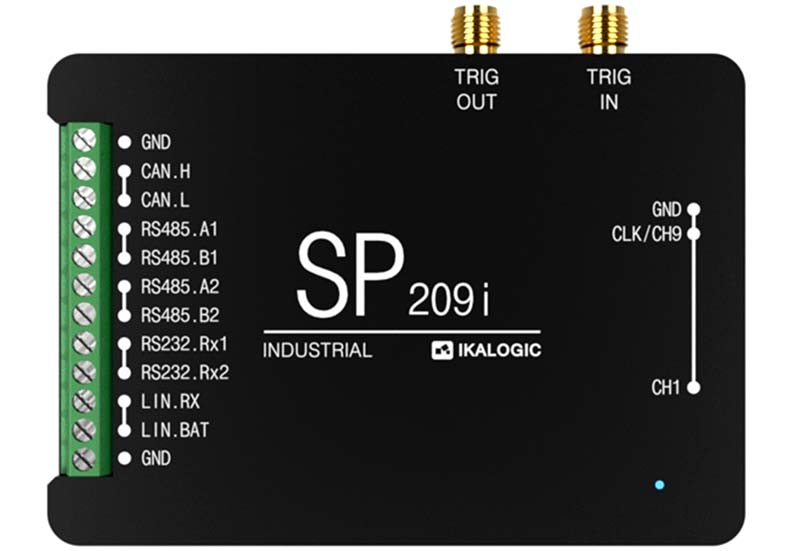
Saelig Company, Inc., has introduced the Ikalogic SP2 series of compact nine-channel 200 MHz logic analyzers which offer in-depth analysis of logic signals and protocol decoding with 200 MHz (5 ns) timing resolution. The nine-channel design allows eight-bit parallel data to be captured along with a clock or strobe signal at the maximum sampling rate without any trade-off between the number of active channels and the sampling rate.
This is possible due to an embedded 2 Gb memory that buffers the captured signals before sending to the attached PC. Powerful trigger options are provided including: edge trigger; logic change on one or various channels; trigger on timed logic signals sequence; trigger on protocol word or event (e.g., serial word or I2C address acknowledge); external trigger input; etc. The SP2 series makes it easy to analyze CMOS logic signals and industrial busses. The series consists of two devices: the SP209 ($399) is the standard edition; and the SP209i ($519) is an industrial version with specialized receivers for most common industrial busses like RS-485, RS-232, or CAN.
The Trigger-in and Trigger-out SMA connectors allow users to synchronize the SP209 to other lab equipment, building highly sophisticated test setups. The Spartan 6 FPGA design provides the processing power required and can easily be firmware-updated. The SP2 series logic analyzers use the supplied ScanaStudio software (Windows, Mac, and Linux) to capture, display, analyze, and decode signals. Most industry standard protocols can be decoded, including: SPI, I2C, USART, 1-Wire, CAN, LIN, RS-232, RS-485, TWI, and more.
The software allows users to capture very long sequences of logic signals (up to 2 Tera samples), or view decoded signals in various levels of abstraction (packets or detailed bits and bytes). It also enables targeting very specific events due to the versatile multi-stage trigger system.
The SP2 series logic analyzers compress and stream captured signals via USB 2.0 to an attached Windows, Linux, or MacOS computer. USB bandwidth can be variable from system to system, with a practical limitation of 20 MB/s. SP2 logic analyzers have an embedded 2 Gb DDR-3 memory which buffers captured samples at 1.6 GB/s to avoid these USB limitations. Features include:
- Nine logic-level channels with adjustable thresholds (1.8V, 2.5V, 3.3V, 5V).
- State-of-the-art input stage, with Schmitt triggers that eliminate glitches on slow signals.
- 200 MHz sampling rate, with all nine channels used.
- External clock option (state mode), up to 50 MHz.
- Precise Trigger-in and Trigger-out signals on SMA ports.
- Sample compression, streaming via USB.
- Embedded receivers on industrial version: SP209i (RS-232, CAN, LIN, RS-485).
For further information, contact:
Saelig Company, Inc.
www.saelig.com
Article Comments